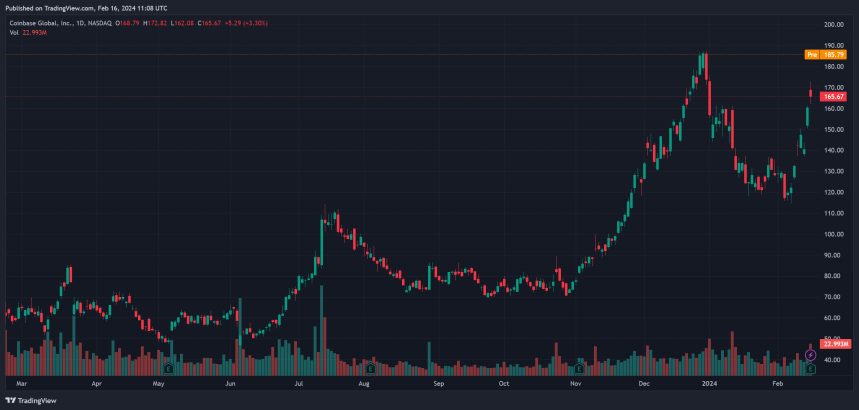 Welcome to Latam Insights, a compendium of Latin America’s most relevant crypto and economic news during the last week. In this issue: President Bukele states El Salvador will not sell its bitcoin, Bitcoin ETFs land in Brazil and Peru, and Argentine President Javier Milei aims to criminalize central bank money issuance. El Salvador Won’t Sell […]
Welcome to Latam Insights, a compendium of Latin America’s most relevant crypto and economic news during the last week. In this issue: President Bukele states El Salvador will not sell its bitcoin, Bitcoin ETFs land in Brazil and Peru, and Argentine President Javier Milei aims to criminalize central bank money issuance. El Salvador Won’t Sell […]
Source link
Insights
4 Surprising Insights From The Coinbase Earnings Report, COIN Sees Bullish Surge
The foremost crypto exchange in the United States, Coinbase, released its earnings report on February 15th. As expected, there were major takeaways from the financial report, highlighting the crypto company’s performance in the fourth quarter of last year.
Coinbase’s Trading Volume Exceeds Expectations
Coinbase maximalist Coinbase Duck noted in an X (formerly Twitter) post how the crypto exchange defied expectations in the fourth quarter of 2023. Coinbase recorded $170.6 billion in spot trading volume, exceeding the estimated $168.
Specifically, a considerable influx of retail investors accounted for 18% of the total spot trading volume against the estimated 16% that the crypto exchange was projected to record. The return of these retail investors is believed to have been partly due to the resurgence that Bitcoin and the broader crypto market experienced towards the end of the year.
Meanwhile, consumer transaction revenue ($492.5 million) was way below the estimate of $570.9 million. However, Coinbase Duck noted that this wasn’t necessarily bad, as some investors started using advanced trading.
In a letter to its shareholders, the crypto exchange also revealed that some existing users traded significantly higher volumes, which could have necessitated the move to advanced trading.
Coinbase also recorded a total operating expense of $838 million, which happened to be below the projected estimate of $878 million. Specifically, the crypto exchange did a great job in its transaction expenses, recording an expense of $126 million compared to the estimate of $163 million.
However, the company’s sales and marketing expenses ($106 million) exceeded the estimate of $90 million. Coinbase revealed that this growth was “primarily driven by higher seasonal NBA spending, higher performance marketing spending due to strong market conditions, and increased USDC reward payouts due to growth in on-platform balances.”
Coinbase Had A Profitable Fourth Quarter
Coinbase recorded a net income of $273 million, beating the estimate of $104 million. Interestingly, going by figures from its Shareholder letter, the fourth quarter of 2023 was the only one in the year in which the crypto exchange didn’t record a loss for its net income. Meanwhile, the company also recorded its largest net revenue during that period.
Coinbase suggested that the excitement around the Spot Bitcoin ETFs and the expectations of more favorable market conditions in 2024 had contributed to its success in Q4 of 2023. Coinbase is a primary custodian for most Bitcoin ETFs, including BlackRock’s iShares Bitcoin Trust (IBIT).
Meanwhile, the crypto exchange earned $1.13 per share, beating the forecast of $0.43. This is without the crypto exchange accounting for the FASB change, which Coinbase Duck revealed could bring its earnings per Share (EPS) to $2.1.

Chart from Tradingview
Disclaimer: The article is provided for educational purposes only. It does not represent the opinions of NewsBTC on whether to buy, sell or hold any investments and naturally investing carries risks. You are advised to conduct your own research before making any investment decisions. Use information provided on this website entirely at your own risk.
The trial against FTX co-founder Sam Bankman-Fried took an intriguing turn as Zac Prince, the CEO of defunct crypto lender BlockFi, provided testimony in a Manhattan federal courtroom.
Prince’s appearance provided valuable insights into the intricate relationship between BlockFi, FTX, and Alameda Research.
BlockFi’s Bankruptcy Rooted In Alameda And FTX
According to a Bloomberg report, Prince revealed that BlockFi had substantial exposure to Alameda and FTX, estimated at around $1 billion, at the time of BlockFi’s failure in November 2022.
Prince asserted that if the loans to Alameda were still in good standing and the funds on FTX were available, BlockFi would not have filed for bankruptcy. This statement suggests that BlockFi’s financial troubles were closely tied to the collapse of Alameda and FTX.
Prince’s testimony diverged significantly from Caroline Ellison, the government’s star witness, who portrayed Bankman-Fried as the mastermind behind a fraudulent scheme using FTX customer funds for speculative trading at Alameda.
Prince’s account positioned BlockFi as a victim of Bankman-Fried’s alleged schemes, claiming that BlockFi made loans to Alameda based on misleading balance sheets.
Defense lawyers sought to emphasize that BlockFi willingly provided the loans to Alameda, with knowledge of the associated risks.
Creditors Accuse BlockFi Of Inadequate Due Diligence
Prince discussed BlockFi’s due diligence process regarding Alameda’s collateral, comprised of tokens affiliated with FTX. The judge requested plainer terms during Prince’s explanation, prompting an analogy using car loans.
Per the report, the prosecution questioned the adequacy of BlockFi’s due diligence, as creditors accused the company of failing to recognize warning signs before offering substantial loans to Alameda.
Prince’s testimony highlighted that providing “unaudited balance sheets” is an industry norm for borrowers seeking loans. The defense sought to establish that BlockFi knew the risks of lending to Alameda and acted within industry norms.
Zac Prince’s testimony in the trial against Sam Bankman-Fried provided a deeper understanding of the intertwined relationships within the crypto industry. BlockFi’s exposure to Alameda and FTX and its subsequent bankruptcy offered insights into the potential repercussions of alleged fraudulent activities.
The differing narratives presented by the prosecution and defense underscore the complexities of the case. As the trial unfolds, the court will continue to examine the details surrounding BlockFi’s lending practices and the extent of Bankman-Fried’s involvement in the alleged schemes.
It is important to note that BlockFi can no longer be utilized for crypto-related activities, as the company declared bankruptcy and suspended withdrawals in November 2022. The bankruptcy filing indicates that BlockFi owes between $1 billion and $10 billion to over 100,000 creditors.
Featured image from NBC, chart from TradingView.com



